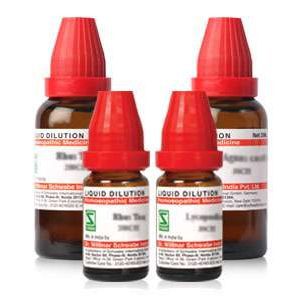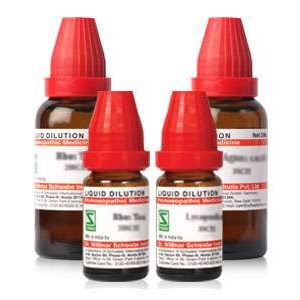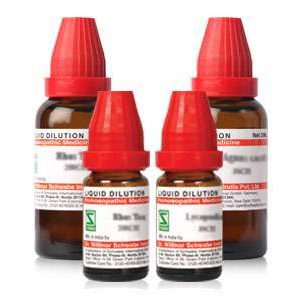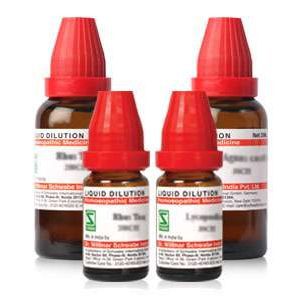
Homeopathy for Skin Rashes: 10 Effective Remedies to Try
- Dr. P T Ponmani
- May 19, 2023
- No Comments

Skin rashes refer to skin color, feeling, or texture changes. They are also called by different names such as redness or inflammation, lesion, rubor, erythema, etc. A skin rash is part of the skin that is irritated or swollen. The rashes are often itchy and painful and can appear differently on different skin tones. For example, while they are often described as red, they may be purple, gray, or white on darker skin tones.
Most often, the cause of the rash can be determined by its looks and symptoms. Skin problems or rashes can be diagnosed by testing, such as a biopsy, but the cause of the inflammation remains unknown in many cases. Rashes have a variety of reasons, from bites to chickenpox to severe conditions like drug allergies.
Causes of skin rashes
A simple rash is called dermatitis or inflammation of the skin. Contact dermatitis is caused by certain things the skin touches, such as:
- Chemicals in elastic, latex, and rubber products
- Cosmetics, soaps, and detergents
- Dyes and other chemicals in clothing
- Insect bites and infection
- Other illnesses
Diagnostic Tests
- Allergy testing
- Blood tests
- Skin biopsy
- Skin scrapings
Skin rashes and their symptoms
Some of the symptoms of specific skin rashes are:
1. Fleabites
- It causes red bumps and scabbing.
- They are found in clusters on the legs and feet
- they are small reddish, itchy eruptions on the skin.
- They may look purplish in hue in darker skin tones.
- Symptoms begin immediately after being bitten
2. Fifth disease
- It is a viral infection caused by parvovirus, which causes a ‘slapped cheek’ rash.
- The symptoms are headache, fatigue, low fever, sore throat, runny nose, diarrhea, and nausea.
- Children are more likely to experience this kind of rash
- The rashes are less notable on darker skin tones
- A lace-patterned rash may appear on the arms, legs, and upper body
Also Read How Homeopathy Resolves Skin Problems?
3. Rosacea
- it is a chronic skin disease with intermittent fading and relapsing.
- Spicy foods, alcohol, sunlight, stress, and the intestinal bacteria Helicobacter pylori may trigger the relapse.
- the symptoms are facial flushing, raised reddish eruptions, redness of the face, skin dryness, and skin sensitivity
- On darker skin tones, brown or yellowish-brown eruptions may have a dusky discoloration
4. Impetigo
- This image also depicts impetigo on dark skin.
- It is most common in children around 2 to 5 years old but may affect any age group.
- The eruptions are found near the mouth, chin, and nose.
- The rashes are fluid-filled blisters that pop and form a honey-colored crust..
- It can also appear brown, purple, or gray on darker skin tones
5. Ringworm
- The eruptions are itchy, circular, and scaly patches with raised edges.
- The patches can appear pink or red or appear grayish.
- The skin in the middle of the eruption seems clear, and the bites of the rings may spread outwards.
6. Contact dermatitis
- The rashes appear hours to days after contact with an allergen.
- It has visible borders and typically occurs where the skin touches the allergen.
- It may be reddish in color and form blisters that weep, ooze, or become crusty.
- Typically itchy, scaly, or raw.
7. Allergic eczema
- It resembles a burn and is often found on the hands and forearms.
- The skin is itchy and scaly with blisters that ooze and become crusty.
- It can appear as reddish, darker brown, purple, or gray patches.
8. Hand-to-foot, and mouth disease
- Usually affects children under the age of 5 years.
- It causes painful, red blisters in the mouth, tongue, and gums.
- Reddish-colored flat or raised red spots on the palms and soles.
- It can appear as skin-colored or grayish-brown spots.
- Marks may also appear on the buttocks or genital area.
9. Diaper rash
- Diaper rashes are located in the regions that come in contact with a diaper.
- The skin looks red, wet, and slightly lighter or darker than the typical skin color.
- It may be warm to the touch.
10. Eczema
- It causes dry, rough, flaky, inflamed, and irritated skin.
- The affected areas may appear red and itchy.
- The areas of the patch or spots become hairless.
- Eczema also appears as darker brown or gray patches
11. Chickenpox
- The condition causes clusters of itchy, red, fluid-filled blisters all over the body
- during different stages of the infection.
- They appear as small eruptions, sometimes a little darker or grayish.
- The rashes are accompanied by fever, body aches, sore throat, and loss of appetite accompany the rashes.
- The condition is contagious until all blisters have crusted and fallen off.
12. Systemic lupus erythematosus (SLE)
- SLE systemic lupus erythematosus
- is an autoimmune disease. Also called butterfly rashes, the condition causes various symptoms involving multiple vital organs.
- The rashes develop in the skin and mucous membrane, causing ulcers.
- Causes a classic butterfly-shaped facial inflammation that extends across the cheeks and over the nose.
- The rashes may appear bright reddish, brown, or darker than the original skin color rashes may occur or get worse with sun exposure.
13. Tick bite
- It is usually painless and causes minor symptoms, such as a sudden or gradual change in skin color, swelling, or soreness.
- Rash develops locally with a burning sensation or as blisters.
- If the person develops breathing difficulty, the condition requires immediate medical attention.
- The rashes look like a circular patch expanding outwards. Most people with Lyme disease develop this rash.
14. Seborrheic eczema
- The eruptions are yellow or white scaly patches that flake off.
- Affected areas may be red, itchy, and greasy patches.
- The affected area tends to lose hair.
15. Scarlet fever
- The rases appear at the same time or right after a streptococcal throat infection.
- The rash is tiny bumps that feel like sandpaper.
- The tongue is bright red.
- There are bright red rashes all over the body but not on the palms and soles.
16. Kawasaki disease
- It is a medical condition that needs immediate emergency attention and care.
- It usually affects children under the age of 5 years.
- The tongue is red with cracked lips and swollen tongue.
- There is a high fever, swollen reddish palms and soles, swollen lymph nodes, and bloodshot eyes.
- It may cause severe heart problems.
Also Read 10 Winter Skincare Tips for a Head-To-Toe Glow
17. Psoriasis
- Psoriasis is an inflammatory skin disorder that leads to dry, itching, and scaly plaques on the skin. It is an autoimmune and genetically related disorder.
- The rashes are silver-colored, dark, purplish, and scaly in appearance.
- They are often located on the scalp, elbows, knees, and lower back.
- It may be itchy or asymptomatic.
18. Shingles
- in this condition, the rash is excruciating, with burning, tingling, or severe itching.
- They appear as fluid-filled clusters which form blisters that break easily and ooze fluid.
- The rashes appear in a band-like pattern, most commonly on the body but may occur on other parts, including the face.
- It may be accompanied by low fever, chills, headache, or fatigue.
19. Cellulitis
- it is one of the severe skin disorders which requires immediate care.
- It is caused by bacteria or fungi that enter through any crack or cut in the skin.
- The rashes are red, pink, brown, gray, or purple.
- They are very painful, swollen skin with or without oozing and spread quickly.
- They are hot and tender to the touch.
- It might be a sign of severe infection requiring medical attention.
20. Drug allergy
- This condition is also considered a medical emergency.
- The symptoms are mild to painful, with rashes that are itchy and reddish and occur days to weeks after taking a drug.
- Sometimes severe drug allergies can be life-threatening, with symptoms of rash, blisters, hives, swelling, itching, difficulty breathing, and rapid pulse.
- Other symptoms are fever, stomach upset, and tiny purple or red dots on the skin.
21. Scabies
- Scabies is a skin infestation that causes rashes and skin eruptions. Mites cause them.
- The symptoms may appear gradually and manifest in around 2 to 5 weeks.
- The rashes are intensely itching with small bumps that may be scaly or raised, with white or flesh-toned lines.
22. Measles
- The common symptoms of measles infection are fever, sore throat, redness of eyes, loss of appetite, cold, cough, and running nose.
- The rash may be reddish or skin-colored or usually darker than the skin tone.
- The rash spreads downwards from the face to the body 3 to 5 days after the appearance of the first symptom.
- Small white spots have a bluish-white central area with a red background inside the mouth.
Causes of skin rashes in Children
Children are more prone to rashes that develop as a result of illnesses:
- For example, a virus causes chickenpox, and small itchy bumps and blisters on the body characterize the rash.
- Measles is a viral infection with respiratory problems that causes a widespread rash of itchy, red bumps.
- Scarlet fever is an infection from group A Streptococcus bacterium that releases a toxin that causes a bright red, sandpaper-like rash.
- The Hand to foot-and-mouth disease is also a viral infection that causes red thrushes on the mouth and reddish rashes on the hands and feet.
- The fifth disease is also a viral infection that leads to a red, flat rash on the body.
- Kawasaki disease is a sporadic but severe illness that triggers some rashes and a high fever in the early stages of the infection that may lead to heart complications if left untreated.
- Impetigo is a contagious bacterial infection with itchy rashes and yellowish, fluid-filled sores on the affected parts.
When to seek medical help
Some rashes can be severe and due to some other illness. So, you must seek professional help immediately if you have these symptoms.
- Shortness of breath
- Tightness or constriction of the throat
- Swelling of face
- Purple rash that looks like a bruise
- Joint pain, fever, or a sore throat
- Streaks of redness, swelling, or tenderness
- Any insect bites
- If home treatment doesn’t work
- Symptoms get worse
- Discoloration in the affected parts
- constriction of the throat
- Difficulty breathing
- Swollen face or legs
- Very high fever of 100.4°f
- Confusion and dizziness
- Severe head or neck pain
- Repeated vomiting or diarrhea
Steps to ease the itching, pain, and discomfort
- Use mild, gentle cleansers instead of scented soaps or liquids.
- Use warm water for washing the skin or hair.
- After cleaning, dab the rash dry instead of rubbing it.
- Avoid covering the rashes with clothes.
- Avoid using perfumes or lotions that may trigger the rash.
- Apply natural moisturizing lotion to areas affected by eczema.
- Avoid scratching on the rash because it can worsen it and cause bleeding.
- Apply antiseptic cream to the affected area if the rash is itchy and causing pain and discomfort.
- Some natural aloe vera lotions help relieve itching from chickenpox rashes, poison ivy, etc.
- An oatmeal bath can soothe the itchiness associated with rashes from eczema or psoriasis.
- Wash the hair and scalp frequently with a good anti-dandruff shampoo.
- Use home remedies to treat mild allergic rashes.
- Identify and avoid any triggers or foods that cause the rash.
- In severe symptoms seek immediate medical help and follow the instructions carefully.
- Avoid scrubbing or scratching the skin.
- Avoid applying cosmetic lotions or creams directly on the rash.
- Use warm water for cleaning.
- Leave the affected area open as much as possible for faster healing.
- Apply moisturizers over the skin if you have dryness or dry eczema.
Treatment options for skin rashes
The treatment depends on the presenting symptoms and underlying cause of the inflammation. Cellulitis can be treated with antibiotics. However, a rash from allergic dermatitis can only be treated with topical creams.
Some of the available modes of treatment to ease the itching and burning of the rashes with fever are:
- Wash the affected area gently with warm water and mildly antiseptic soap.
- Apply cool compresses with cold water.
- Applying moisturizers or corticosteroid creams to reduce itching and inflammation.
- Before doing anything, you should check with your doctor to avoid adverse reactions.
- It is essential to avoid scratching to prevent it from getting worse and scarring.
- Avoid intense perfumes, harsh chemicals, or irritants known to cause allergic reactions on the skin.
- Wear long sleeves and pants while hiking or outdoors to reduce contact with irritating plants and protect against insect bites.
- Wear sunscreen when going outdoors to protect the skin from sunburn and inflammation.
- Avoid long hot showers and expose the skin to water for a long time as it causes chafing of the skin or dries out the natural moisture from the skin.
Complications
If a rash is due to an underlying infection, leaving it untreated could cause complications and lead to sepsis, a severe condition that affects the vital organs and the whole body that can be fatal.
Homeopathic treatment for Skin Rashes and itching
Skin rashes can be of many kinds. A skin is any change in the color and texture of the skin that affects its color, texture, and appearance. A rash may lead to blistering, itching, chafing, chapping, and swelling, along with a color change. The rashes may or may not be accompanied by pain. A skin rash can be localized or generalized and spread all over the body. Not only discomfort or pain, but a skin rash may also lower your self-esteem if it affects the person’s looks. Some skin rashes disappear spontaneously, like the heat rash and swimmer’s itch, while others, such as rosacea and shingles, call for medical intervention.
Homeopathic Medicine for skin rashes and itching
Homeopathic remedies for skin rashes are safe and supple on the skin as they are mild, natural, and harmless without any side effects. Though a few kinds of rashes disappear without treatment, other rashes may require medical attention. Homeopathy offers various medicines that can treat skin diseases and infections effectively without any adverse effects. There is no specific medicine for specific infections. Each medicine is selected as per the particular symptom of a particular person. Out of the many medicines available in homeopathy to treat skin rashes, the ten most used remedies are given below. They are:
Top ten remedies to treat skin rashes
- Arsenicum album
- Hepar Sulphuricum
- Psorinum
- Apis Mellifica
- Caladium
- Medorrhinum
- Sulfur
- Belladonna
- Graphites
- Petroleum
-
 Dr Willmar Schwabe India Psorinum CHSale Product on sale
Dr Willmar Schwabe India Psorinum CHSale Product on sale₹105.00₹86.10 -
 Dr Willmar Schwabe India Petroleum CHSale Product on sale
Dr Willmar Schwabe India Petroleum CHSale Product on sale₹105.00₹86.10Rated 5.00 out of 5 based on 1 customer rating -
 Dr Willmar Schwabe India Medorrhinum CHSale Product on sale
Dr Willmar Schwabe India Medorrhinum CHSale Product on sale₹105.00₹86.10 -
 Dr Willmar Schwabe India Graphites CHSale Product on sale
Dr Willmar Schwabe India Graphites CHSale Product on sale₹105.00₹86.10 -
 Dr Willmar Schwabe India Caladium seguinum CHSale Product on sale
Dr Willmar Schwabe India Caladium seguinum CHSale Product on sale₹105.00₹86.10Rated 5.00 out of 5 based on 1 customer rating -
 Dr Willmar Schwabe India Belladonna CHSale Product on sale
Dr Willmar Schwabe India Belladonna CHSale Product on sale₹105.00₹86.10Rated 4.50 out of 5 based on 2 customer ratings -
 Dr Willmar Schwabe India Apis mellifica CHSale Product on sale
Dr Willmar Schwabe India Apis mellifica CHSale Product on sale₹105.00₹86.10 -
 Dr Willmar Schwabe India Arsenicum album CHSale Product on sale
Dr Willmar Schwabe India Arsenicum album CHSale Product on sale₹105.00₹86.10Rated 5.00 out of 5 based on 10 customer ratings
There are other medicines as well that act well on skin rashes. The drugs are also available online. In addition, various specialized homeopathic combination products are also available for specific skin rashes. It should be taken under the guidance of a registered homeopathic physician to know about the details of the dosage and time to be taken.
Takeaway
A rash on the extremities can result from a bacterial or fungal infection, an underlying severe health condition, or a particular chronic medication. A rash is described as any sudden changes in a person’s normal skin appearance. In such cases, the skin becomes red and itchy, often accompanied by a burning sensation and a hot feeling when touched.
It is due to enhanced blood flow to the area as a response to inflammation. A rash that is hot to the touch can signify a mild or more severe case.
Any change in the color and texture of the skin earmarks rashes. They may develop blisters that itch or hurt. Rashes that break out on the hands and





































